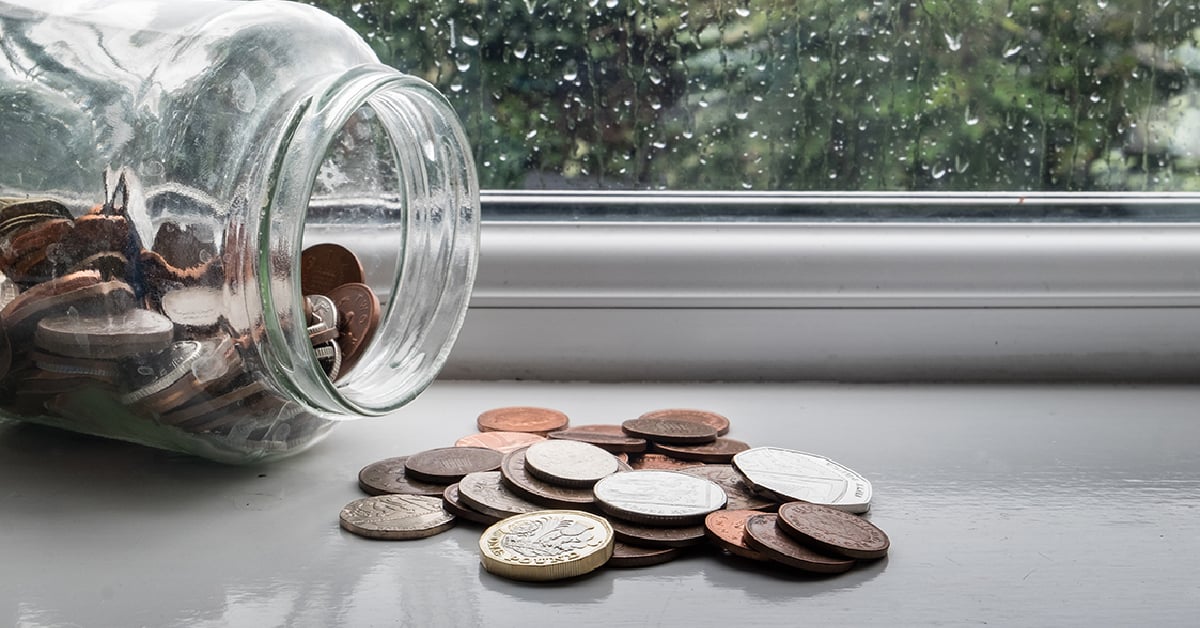
Do you need to have a separate rainy-day fund and emergency fund? In an effort to simplify their money, people sometimes consolidate their accounts. This is OK in many instances, but it’s important to remember that rainy day funds and emergency funds serve different purposes. Additionally, it’s important to have not just one, but both funds available to tap into as needed.
Why have a rainy-day fund?
Say your washing machine decides to suddenly quit on you and needs replacing. You’re now looking at an extra expense that can run anywhere from $350-$850 (or more). Where are you going to get that kind of money in a pinch? According to a Federal Reserve Board report, if you’re like 44% of Americans, you’ll need to sell something you own or borrow money to fund such an unexpected expense. Or, you might choose to charge the purchase to a credit card, which means you’ll pay extra in interest, and the cost of the new machine will be haunting you for months — or even years — to come. Either way, a surprise expense of a few hundred dollars can be enough to send you into a tailspin of debt.
Is there a solution?
Here’s where your rainy-day fund comes in. It’s a small savings account created just for these types of small expenses that you know will crop up on occasion. You’ll tap into your fund to pay for minor household and car repairs, to cover the cost of summer camp for your child, or to replace your broken kitchen table. When you have a way to fund these small financial hiccups, they won’t have as much of a chance to disrupt your financial health.
Why have an emergency fund?
In contrast to your rainy-day fund, an emergency fund is for much larger expenses. It should have enough padding to keep you afloat even if you experience a major unexpected disruption in your life, like a divorce, job loss, or illness. Without an emergency fund, you can be left scrambling to pay your bills, and quickly end up in a debt trap that can last years.
How much money should be in each fund?
Your rainy-day fund, created for minor expenses, only needs to hold $500-$1,000. That should be enough to tide you over in the event of a small, unfixed expense.
Sometimes, you may be able to anticipate these expenses and save up for them accordingly. For example, if you know your child will need braces next year or that your HVAC system will need replacing in a year or two, you can build up your rainy-day fund over the next several months until it has enough to fund these anticipated expenses.
Your emergency fund, however, should be positioned to pull you through major financial crises. That’s why you will need to have a lot more money in the account. Ideally, it should hold 3-6 months’ worth of your living expenses. This value will vary according to circumstance and can be anywhere from $3,000-$10,000, or more.
Where should I keep these funds?
The cash in both of these funds needs to be easily accessible. Don’t lock the money up in a savings certificate or another long-term savings account that will make it difficult and/or expensive to withdraw when the need arises.
Your MyLife Savings Account is a perfect home for both your rainy-day fund, and your emergency fund. Your money is always safe here, and you will even get an extra savings boost on your first $500. Best of all, you’re free to withdraw your funds without penalty whenever you need to do so.
How can I build my funds?
You’re convinced: You need an emergency fund and a rainy-day fund. But how are you going to get the money for both? If you’ve never saved up for unexpected expenses before, the prospect of doing so can be daunting. No worries, though. With a bit of discipline and hard work it can be done! Use these three tips to build your funds:
- Start a side hustle. Freelance for hire, take online surveys for spare cash, or accept a seasonal position. Keep all or most of the extra money you pull in for your funds, making equal contributions to each.
- Trim your budget. Take a long hard look at where your money goes each month and choose your biggest money-gobbler to be removed. Use the money you save for your funds.
- Make it automatic. Set up an automatic transfer from your checking account to your savings accounts, so your funds grow on autopilot and are less tempting to use for fun.
It may be some time before your funds are fully padded, but that’s OK. It takes time to save up that kind of money, and hopefully you won’t need to tap into your savings until you’ve successfully built your funds. Also, you won’t need to stick to your tightened budget or keep your extra job forever; you can drop both as soon as your funds are built, taking them up again only when the money in one of them is depleted. Start setting up your rainy-day and emergency funds today, and you’ll sleep better at night knowing you’re prepared for any financial eventuality.


Comments